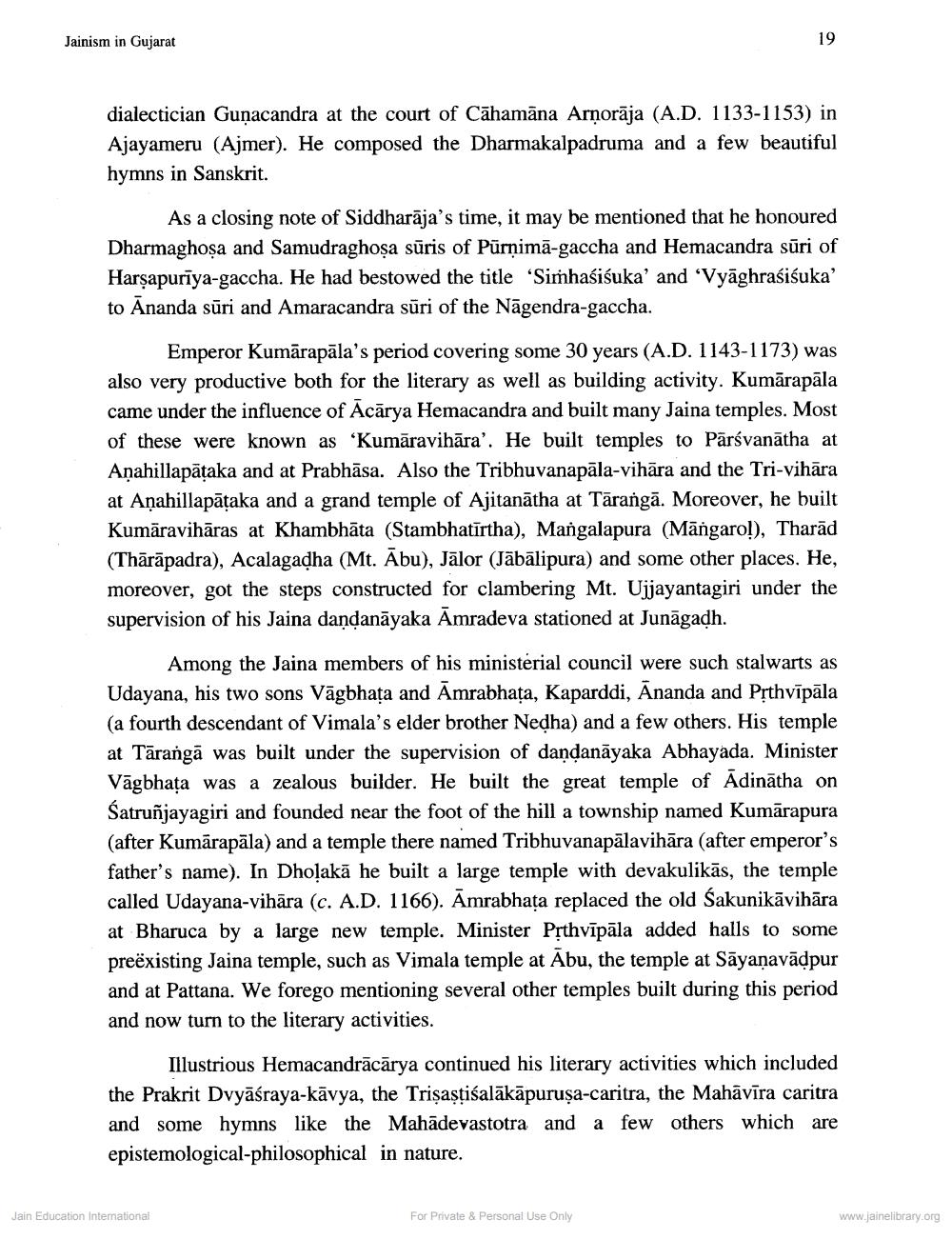________________
Jainism in Gujarat
19
dialectician Gunacandra at the court of Cāhamāna Arņorāja (A.D. 1133-1153) in
jayameru (Ajmer). He composed the Dharmakalpadruma and a few beautiful hymns in Sanskrit.
As a closing note of Siddharāja's time, it may be mentioned that he honoured Dharmaghoșa and Samudraghoṣa sūris of Pūrņimā-gaccha and Hemacandra sūri of Harsapuriya-gaccha. He had bestowed the title 'Simhaśiśuka' and 'Vyāghraśiśuka' to Ananda sūri and Amaracandra sūri of the Nāgendra-gaccha.
Emperor Kumārapāla's period covering some 30 years (A.D. 1143-1173) was also very productive both for the literary as well as building activity. Kumārapāla came under the influence of Acārya Hemacandra and built many Jaina temples. Most of these were known as 'Kumāravihāra'. He built temples to Pārsvanātha at Anahillapātaka and at Prabhāsa. Also the Tribhuvanapāla-vihāra and the Tri-vihāra at Anahillapātaka and a grand temple of Ajitanātha at Tārangā. Moreover, he built Kumāravihāras at Khambhāta (Stambhatīrtha), Mangalapura (Māngaro!), Tharād (Thārāpadra), Acalagadha (Mt. Ābu), Jālor (Jābālipura) and some other places. He, moreover, got the steps constructed for clambering Mt. Ujjayantagiri under the supervision of his Jaina dandanāyaka Amradeva stationed at Junāgadh.
Among the Jaina members of his ministerial council were such stalwarts as Udayana, his two sons Vāgbhata and Amrabhata, Kaparddi, Ananda and Prthvīpāla (a fourth descendant of Vimala's elder brother Nedha) and a few others. His temple at Tārangā was built under the supervision of dandanāyaka Abhayada. Minister Vāgbhata was a zealous builder. He built the great temple of Ādinātha on Śatruñjayagiri and founded near the foot of the hill a township named Kumārapura (after Kumārapāla) and a temple there named Tribhuvanapālavihāra (after emperor's father's name). In Dholakā he built a large temple with devakulikās, the temple called Udayana-vihāra (c. A.D. 1166). Amrabhata replaced the old Sakunikāvihāra at Bharuca by a large new temple. Minister Prthvīpāla added halls to some preëxisting Jaina temple, such as Vimala temple at Abu, the temple at Sāyanavādpur and at Pattana. We forego mentioning several other temples built during this period and now turn to the literary activities.
Illustrious Hemacandrācārya continued his literary activities which included the Prakrit Dvyāśraya-kāvya, the Trişastiśalākāpuruşa-caritra, the Mahāvīra caritra and some hymns like the Mahādevastotra and a few others which are epistemological-philosophical in nature.
Jain Education International
For Private & Personal Use Only
www.jainelibrary.org




